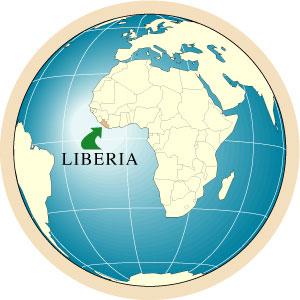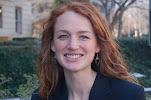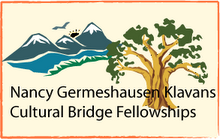"You know what we really need?"
Minister Antoinette Sayeh and I were sitting together in her office on the ninth floor, pausing our frenetic workday in Liberia's Ministry of Finance to eat lunch together in what had become one of my very favorite rituals of my summer internship. At this moment, we had just turned to a discussion of the Gender Ministry's role in Liberia's Poverty Reduction Strategy.
"To really advance the cause of women in Liberia," she said," "what we need is data. Hard data and rigorous economic analysis." Without such data, the policy agenda for Liberian women would be more of the same: one-off benchmarks (training xx numbers of women in sewing, for instance, or providing xx numbers of women with business training), without a broader strategy to fundamentally change economic opportunities for women. And, importantly, without the ability to measure progress.
That night I went home to the "Baptist Compound," to a late dinner with the fellow members of Team Liberia. Over fried plantains and jollof rice, I shared my lunchtime discussion with my rock star classmate, Emily Stanger. Minister Sayeh's comments were music to Emily's ears. A deeply passionate advocate of women and a dynamite intern in Liberia's Ministry of Gender and Development, Emily also happens to be a brilliant economist who loves data.
Thus the seeds were sown for a year-long collaboration. Heeding Minister Sayeh's call, Emily and I came together, combining the mission of the Ministry of Gender with the Ministry of Finance's purview of technical economic policies. The former our inspiration, the latter our medium for impact.
Minister Antoinette Sayeh and I were sitting together in her office on the ninth floor, pausing our frenetic workday in Liberia's Ministry of Finance to eat lunch together in what had become one of my very favorite rituals of my summer internship. At this moment, we had just turned to a discussion of the Gender Ministry's role in Liberia's Poverty Reduction Strategy.
"To really advance the cause of women in Liberia," she said," "what we need is data. Hard data and rigorous economic analysis." Without such data, the policy agenda for Liberian women would be more of the same: one-off benchmarks (training xx numbers of women in sewing, for instance, or providing xx numbers of women with business training), without a broader strategy to fundamentally change economic opportunities for women. And, importantly, without the ability to measure progress.
That night I went home to the "Baptist Compound," to a late dinner with the fellow members of Team Liberia. Over fried plantains and jollof rice, I shared my lunchtime discussion with my rock star classmate, Emily Stanger. Minister Sayeh's comments were music to Emily's ears. A deeply passionate advocate of women and a dynamite intern in Liberia's Ministry of Gender and Development, Emily also happens to be a brilliant economist who loves data.
Thus the seeds were sown for a year-long collaboration. Heeding Minister Sayeh's call, Emily and I came together, combining the mission of the Ministry of Gender with the Ministry of Finance's purview of technical economic policies. The former our inspiration, the latter our medium for impact.

A woman in rural Gbarpalu county, answering the question posed by our Team Liberia group about what the greatest needs in their community were. (Her answer: better income-generating opportunities for women, such as peanut farming)
Returning to our final year in the MPA/ID program at Harvard's Kennedy School just a few weeks later, Emily and I endeavored to co-write our masters thesis (under the advisement of our professor Rohini Pande) on the following questions:
- Where are Liberia's women in the economy? What sectors do they work in, and what are characteristics of their work and pay?
- How will Liberia's projected growth over the next three years affect women? Do women stand to benefit from this growth?
- What are specific actions that the Liberian government can take during President's Sirleaf to fulfill her pledge to Liberia's women, particularly in three sectors: agriculture, the informal urban sector, and formal employment?
Our premise was that Liberia had abundant political will to address the economic plight of its women. Indeed, President Sirleaf was elected in no small part because of the electoral support of women, deemed her "greatest constituency." She had vowed in her inaugural address to "try to provide economic programs that enable Liberian women - particularly our market women -- to assume their proper place in our economic process." (See my earlier blog post about Sirleaf's commitment to women). Rather, what was missing in turning this campaign pledge into reality was data and some hard-headed analysis, which we set out to provide.
After a bit of cajoling and relentless pestering, Emily and I got our hands on our gold mine: Liberia's first sex-disaggregated household data in nearly two decades. Two data sources had just emerged, after nearly two decades of civil war: the Core Welfare Indicator Questionnaire (CWIQ), a nationally representative household survey, and the Comprehensive Food Security and Nutrition Survey (CFSNS), which had three separate reports including a rural report, an urban report, and a market review. So new was this data and so eager was Emily to dive into it that our research was the first time that the CWIQ analysis was presented to the Government of Liberia.
Where are women in Liberia's economy?
Through this data, we were able to paint an economic picture of Liberia's women. The following are a few of the most salient characteristics. Unfortunately I haven't been able to upload Emily's gorgeous charts and graphs to this blog, so please see our 4-page policy brief to do justice to Emily's masterful work.
- Liberian women comprise the majority (54%) of Liberia's labor force
- The vast majority (90%) of women workers are clustered in the least productive sectors
- Urban working women are predominantly self-employed (74%), mainly in street vending and as market women. Men are 2.5 times more likely to be skilled workers.
- Women conduct 85% of marketing and trading and contribute 75% of all cash and food production.
- As major economic actors, women make significant contributions to household income; alone and with other household members, women contribute to 65% of urban household income and 45% of rural.
Women left out of Liberia's projected economic growth
Now the bad news for the Sirleaf Administration and Liberian women. Looking ahead to the next few years of economic growth and revitalization in Liberia, male-dominated sectors stand to grow the most: timber, mining and extractive industries in particular. Men greatly outnumber women in all of these sectors, which has alarming distributional effects for women workers. As male-dominated sectors grow as a proportion of Liberia's GDP, women's labor contribution to GDP will fall from 44 percent in 2007 to 36 percent in 2011. Although the absolute labor contribution of women will increase, this proportional reduction in women's contribution shows the unequal distribution of Liberia's growth. Female labor will contribute to, and thus benefit from, less than one-quarter of the new growth over the next three years.
Why does this matter? If men earn more, would not households still benefit? We argue that the distributional consequences are very serious and do, in fact, matter a great deal. Liberia's protracted civil war claimed the lives of thousands of male breadwinners, placing women as the heads of some 18% of urban households. In other words, providing a better livelihood to Liberian women means supporting entire families. There is also extensive research that shows that increasing women's income and household resources has direct development implications -- it improves child welfare and development, and can reduce fertility and promote growth.
Beyond these reasons, our primary justification is more basic: that improving the economic opportunities facing women is development, in and of itself. Today Liberian women are fully engaged economic actors, comprising more than half of the total labor force and leading many of the most vibrant sectors of the economy, including the markets. Helping these women eke out a better living, to be more productive, more prosperous, to access better resources, to bolster their capacity and abilities, and to take advantage of improved economic opportunities -- we argue this is not only politically necessary in Liberia, but also development at its core.

Women in a village in rural Gbarpalu county during a visit in August 2007
What Sirleaf's Administration can do for Liberian women
After looking at where women are in Liberia's economy and estimating how they will (or will not) benefit from the country's projected economic growth, Emily and I then turned to the pertinent question: what can Sirleaf's government do, in the next few years, to deliver on the President's political promise to improve the economic conditions for her country's women? In our thesis, Emily and I put forth three sets of policy recommendations that we considered feasible and realistic for Liberian government action: for women in agriculture, women in the informal sector, and women in the formal economy.
(1) Women in Agriculture: Build More Rural Roads.
To strengthen opportunities for rural women, the Government of Liberia should prioritize the construction of farm-to-market and rural access roads. Roads -- identified by rural Liberians as the primary constraint to development -- are critical for the agricultural work of rural women. Across the rural areas, Liberians must travel an average of three hours to reach food markets. Women conduct 85% of agricultural marketing and trading, and bear much of the burden of inadequate roads and transportation infrastructure. Prioritizing roads will decrease this transport burden on women, enhance their efficiency, and create income-generating opportunities for rural women.
(2) Women in the Informal Sector: Expand Access to Credit
In urban areas, 75% of women are self-employed. Yet as of 2007, less than 1% of these women access formal credit to support their businesses. In all of Liberia (in 2007), just two MFIs were serving 5,726 women. This number pales in comparison to the estimated 174,000 market women in Liberia, to say nothing of the greater number of female petty traders. The Government of Liberia should create the appropriate regulatory environment for the expansion of the microfinance sector, and ensure that small-scale micro enterprises are prioritized in SME financing strategies. (Less than 20% of informal enterprises are owned by women, whereas 85% of petty trading and marketers are women). Microfinance should also be paired with skills and business training.

A woman selling vegetables on a street in downtown Monrovia
(3) Women in the Formal Economy: Improve Business Climate
Many countries with successful labor-intensive industries have employed a very large percentage of female workers: in horticulture, jewelry making, garments and toys. In Liberia, it might be tempting to attempt to stimulate these types of industries through the creation of an Export Processing Zone (EPZ). Yet EPZs have had little success in Africa, would be administratively and fiscally infeasible right now in Liberia, and most importantly, would not address the most serious underlying constraints on investment. Instead, to lay the foundation for the emergence of nontraditional industries over the next 5-10 years that employ women, the Government should take steps to improve the overall business environment and investment climate.
Research to Policy: Sharing our Findings in Liberia
Once Emily and I finally had our research findings and our thesis in hand in the spring of our final year at the Kennedy School, this was really just the beginning. While our academic requirements box had been checked, we were both bound and determined to make our research useful and have an impact on policy in Liberia and, ultimately, Liberia's women. Taking a page from the Center for Global Development's smart and savvy communications, we turned our unwieldy 80-page thesis into a short, colorful, heavily imaged 4-page policy brief, based on the assumption that busy policymakers would never read our long thesis. (Let's be honest, I'm not even convinced our parents read every last page, and they are as proud as parents can be!)
Many countries with successful labor-intensive industries have employed a very large percentage of female workers: in horticulture, jewelry making, garments and toys. In Liberia, it might be tempting to attempt to stimulate these types of industries through the creation of an Export Processing Zone (EPZ). Yet EPZs have had little success in Africa, would be administratively and fiscally infeasible right now in Liberia, and most importantly, would not address the most serious underlying constraints on investment. Instead, to lay the foundation for the emergence of nontraditional industries over the next 5-10 years that employ women, the Government should take steps to improve the overall business environment and investment climate.
Research to Policy: Sharing our Findings in Liberia
Once Emily and I finally had our research findings and our thesis in hand in the spring of our final year at the Kennedy School, this was really just the beginning. While our academic requirements box had been checked, we were both bound and determined to make our research useful and have an impact on policy in Liberia and, ultimately, Liberia's women. Taking a page from the Center for Global Development's smart and savvy communications, we turned our unwieldy 80-page thesis into a short, colorful, heavily imaged 4-page policy brief, based on the assumption that busy policymakers would never read our long thesis. (Let's be honest, I'm not even convinced our parents read every last page, and they are as proud as parents can be!)
Our next step was to share the brief and our findings with those that could actually act on them. Emily sent our research to her colleagues at the Ministry of Gender and to their partners in the international community. When Minister Sayeh was in Washington for the IMF-Spring meetings, Emily and I traveled to Washington for a reunion and shared with her the brief.

Serendipitously, just a few months later, President Sirleaf was invited to deliver the commencement address during our graduation from the Kennedy School. Moments before President Sirleaf was to address the graduates and our families, our Dean invited "Team Liberia" into his office to visit with the President. Emily and I presented President Sirleaf a copy of our thesis, which had been recognized the day before with an award from Harvard's Women and Public Policy Program. Emily and I were thrilled to have the opportunity to share our work directly with the President herself. A few weeks later President Sirleaf sent us a request for 500 of our policy briefs to "disseminate widely" in Liberia. (Proving our theory that a 4 page brief is eminently more useful to policymakers than an 80-page thesis.)


Emily and I presenting President Sirleaf with our masters thesis
Looking Forward: Advancing the Cause of Liberian Women
For me, this is largely where the story ends. But for my partner-in-crime, Emily Stanger, this was just the start. After a brief stint working for Cherie Blair on her new womens-focused foundation after graduation, Emily has been back in Liberia for the past year, working as an Ed Scott Liberia Fellow in the Ministry of Gender and Development and helping to manage the Nike Foundation-World Bank project for adolescent girls. She is currently working for the UN on these same gender issues. I am so proud of Emily's commitment to Liberian women, for continuing to advance these causes on a daily basis, and for contributing her boundless energy, unparalleled talents, smarts, and economic know-how to this endeavor to advance the economic plight of women in Liberia. Emily, you are a marvel and a role model in so many ways.

For me, this is largely where the story ends. But for my partner-in-crime, Emily Stanger, this was just the start. After a brief stint working for Cherie Blair on her new womens-focused foundation after graduation, Emily has been back in Liberia for the past year, working as an Ed Scott Liberia Fellow in the Ministry of Gender and Development and helping to manage the Nike Foundation-World Bank project for adolescent girls. She is currently working for the UN on these same gender issues. I am so proud of Emily's commitment to Liberian women, for continuing to advance these causes on a daily basis, and for contributing her boundless energy, unparalleled talents, smarts, and economic know-how to this endeavor to advance the economic plight of women in Liberia. Emily, you are a marvel and a role model in so many ways.









